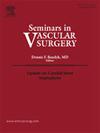Management of claudication in older adults and the role of exercise therapy
IF 2.4
3区 医学
Q1 PERIPHERAL VASCULAR DISEASE
引用次数: 0
Abstract
Claudication from peripheral artery disease is a common mobility-limiting condition in older adults. Exercise therapy, whether delivered through supervised programs or structured home-based programs, plays a central role in claudication care for older adults, offering substantial functional gains with minimal risk, and should be the cornerstone of management alongside optimized medical therapy. This review examines contemporary management of claudication in the aging population, with emphasis on exercise therapy. Treatment modalities, including best medical therapy, supervised exercise therapy, home-based exercise programs, and invasive interventions (endovascular and open surgery) are critically evaluated. Pharmacotherapy (eg, cilostazol) can modestly improve walking distance, and aggressive risk factor control (eg, smoking cessation and statins) is imperative for all patients. Invasive revascularization is reserved for select individuals with lifestyle-limiting claudication unresponsive to conservative measures, given procedural risks and the potential for repeated interventions. Recent society guidelines (American College of Cardiology and the American Heart Association 2016 and European Society for Vascular Surgery 2024) and the Society for Vascular Surgery's 2025 focused update uniformly endorse exercise and medical therapy as initial management, restricting revascularization to severe claudication after conservative therapy trials and emphasizing individualized shared decision-making approaches. Claudication outcomes (ankle–brachial index changes, 6-minute walk improvements, and patient-reported outcomes) across treatments are reviewed alongside indications, contraindications, and benefits of each strategy.
老年人跛行的管理和运动治疗的作用
外周动脉疾病引起的跛行是老年人常见的活动受限疾病。运动疗法,无论是通过有监督的项目还是有组织的家庭项目,在老年人的跛行护理中发挥着核心作用,以最小的风险提供大量的功能收益,应该成为优化药物治疗的管理基石。这篇综述探讨了老年人群跛行的当代管理,重点是运动疗法。治疗方式,包括最好的药物治疗,监督运动治疗,以家庭为基础的锻炼计划,和侵入性干预(血管内和开放手术)进行严格评估。药物治疗(如西洛他唑)可以适度改善步行距离,积极的危险因素控制(如戒烟和他汀类药物)对所有患者都是必要的。考虑到手术风险和重复干预的可能性,有创性血运重建术只适用于生活方式受限的跛行患者。最近的社会指南(美国心脏病学会和美国心脏协会2016年和欧洲血管外科学会2024年)和血管外科学会2025年的重点更新一致支持运动和药物治疗作为初始管理,限制在保守治疗试验后的严重跛行血供重建术,并强调个性化的共同决策方法。不同治疗的跛行结果(踝-肱指数改变、6分钟步行改善和患者报告的结果)以及每种策略的适应症、禁忌症和益处进行了回顾。
本文章由计算机程序翻译,如有差异,请以英文原文为准。
求助全文
约1分钟内获得全文
求助全文
来源期刊
CiteScore
3.50
自引率
4.00%
发文量
54
审稿时长
50 days
期刊介绍:
Each issue of Seminars in Vascular Surgery examines the latest thinking on a particular clinical problem and features new diagnostic and operative techniques. The journal allows practitioners to expand their capabilities and to keep pace with the most rapidly evolving areas of surgery.

 求助内容:
求助内容: 应助结果提醒方式:
应助结果提醒方式:


